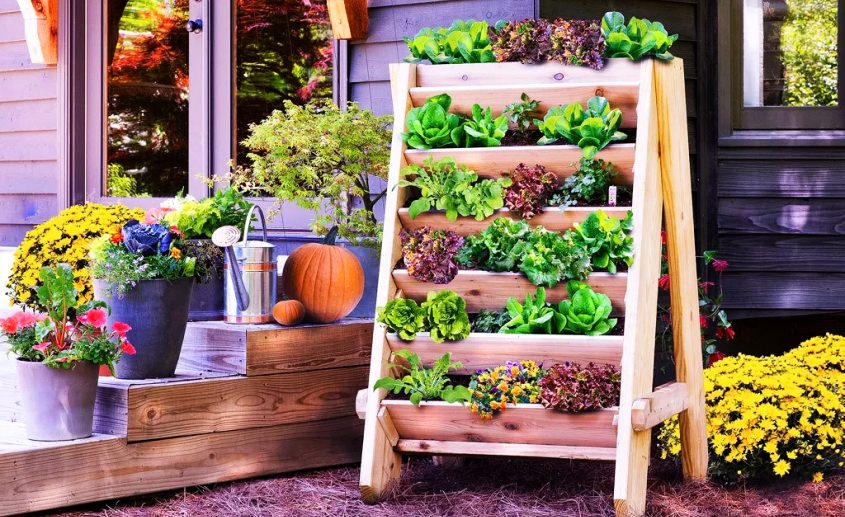There are many people who are very passionate about what they do and grow in their garden. Unfortunately, when winters come with the chilling cold, it becomes very hard for most of us to produce and harvest vegetables and herbs outdoors. With the right precautions, it is possible to keep several hearty vegetables warm enough to survive the cold temperatures.
Following budget-friendly, simple ideas can be implemented to grow healthy veggies during winters, and all year long.
Tips to Get Started
Once you have decided the space you can allocate for your plants, these are a few things that you need to pay heed to:
Lighting
Vegetables require plenty of light to cultivate fast. Therefore, it is necessary to choose the environment where they can receive maximum light to develop fully. Even a spot close to the window indoors is not ideal. Don’t worry, if you just have an enclosed space with minimum lighting, you still can grow healthy vegetables using plant lights. There are so many to choose from. Low-priced lights are good to work for outdoor houseplants, however, expensive ones can work better to cover indoor gardens. The best middle of the road option is compact fluorescent bulbs. They provide ample close light to plants without heating them up.
Temperature
Vegetables grow best between 65-75 °F with a slight variation either way. If your plants become too hot, they will be weak and stunted, and if they are too cold, they may develop yellow leaves that fall off. Remember, winters do not harm plants as much as the fluctuating temperature does. So, in winters it is necessary to maintain an ideal temperature for plants that will vary more than 10 °F.
Humidity
This can be the most significant challenge for any indoor vegetable growing. Winters are usually drier than summers, and can lead to the enlisted problems:
- Vegetables lose their leaves
- Your plants look withered
- The tips of the leaves begin to turn brown
To increase humidity, you can mist your vegetables daily or place a tray of water close to your growing area.
Soil and fertilizer
Whether you are growing veggies indoors or outdoors, it is vital to purchase good growing mediums – which obviously are soil and fertilizers. They both encourage your plants’ root growth and ensure their long-term health. Consider using organic and pest-free soils and fertilizers, as they provide extra nutrients to vegetables. Using organic fertilizers also help plants in drainage from excessive watering.
Types of vegetables you can grow
- Peppers, Salad Greens and Kale
- Cabbage
- Chard, Carrots and Onions
- Garlic
- Tomatoes
- Peas
- Carrot
- Beans
- Other herb types
Also Read: Zhejiang Nashou’s Smart Garden Purifies Indoor Air
Windows and window ledges
Windows can make a great indoor greenhouse area for smaller vegetables and herbs. To make a window greenhouse, measure the width and the depth of the window considering the amount of natural light that plants may receive. While choosing the glass window ledges, keep in mind that they have to be sturdy enough to carry the weights of your vegetables. They should be ½ inch thick, and can be sanded to rid any sharp edges. Glass ledges are ideal because they let the light pass through.
Pallet greenhouses
Pallet greenhouses are very effective, cheap and easy to make on the patio to face the sun. To make one, you have to collect bunches of pallets. Spare the most solid pallets to build the roof. Start giving support to the roof from the back with pallets, and then from other sides too. After giving shape to the pallet greenhouse, the most substantial expense comes in the form of the multi-purpose heavy duty clear sheeting. Under normal circumstances, 3m x 4m is the ideal size.
Now cover and secure the sheeting all around the framework. These are quite similar to the 4 tier PVC greenhouses that you can purchase, yet a DIY greenhouse is much cheaper to construct. It gives your vegetables a higher growth area, especially for longer plants such as tomatoes.
Tabletop gardening
If you wish to utilize a larger space indoors, an old table placed in a lightened-space can make a tremendous growth area for veggies. The best idea is to ideally grow short vegetables and herbs, rather than taller ones. All you require for this are larger pots or containers with at least 8 inches depth for your veggies to grow in. It is possible to grow veggies following this procedure anywhere in your home, but a lot more light is still required.
Container gardening
Growing veggies in containers can be fun. Most people think of containers as round pots. In many cases, this is true. Containers, though, can be anything that is large enough to hold the vegetables or herbs you wish to grow.
As you have complete flexibility with containers, you can choose any area of your home to grow vegetables. You are not limited to a just a window, you can place your containers in a balcony too. As the weather becomes colder, you can bring the pots indoors, and put them in an ideal area.
You can even use a shelving unit which stands close to a balcony door; this can comfortably accommodate smaller containers that are large enough to grow a few veggies.
One other container type many people often forget is hanging the basket. If you have a suitable location, these can be attached in areas that have enough light, and the growing conditions are favorable for your vegetable.
All it takes is a little imagination, and you can have fresh vegetables all year round, just keep an eye on the watering though.
Image: Bonnieplants
Follow Homecrux on Google News!




